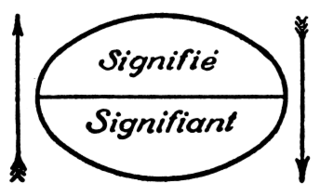Related Research Articles

A sign is an object, quality, event, or entity whose presence or occurrence indicates the probable presence or occurrence of something else. A natural sign bears a causal relation to its object—for instance, thunder is a sign of storm, or medical symptoms a sign of disease. A conventional sign signifies by agreement, as a full stop signifies the end of a sentence; similarly the words and expressions of a language, as well as bodily gestures, can be regarded as signs, expressing particular meanings. The physical objects most commonly referred to as signs generally inform or instruct using written text, symbols, pictures or a combination of these.
Semiotics is the systematic study of sign processes (semiosis) and meaning making. Semiosis is any activity, conduct, or process that involves signs, where a sign is defined as anything that communicates something, usually called a meaning, to the sign's interpreter. The meaning can be intentional, such as a word uttered with a specific meaning; or unintentional, such as a symptom being a sign of a particular medical condition. Signs can also communicate feelings and may communicate internally or through any of the senses: visual, auditory, tactile, olfactory, or gustatory (taste). Contemporary semiotics is a branch of science that studies meaning-making and various types of knowledge.

A symbol is a mark, sign, or a word that indicates, signifies, or it is understood as representing an idea, object, or relationship. Symbols allow people to go beyond what is known or seen by creating linkages between otherwise very different concepts and experiences. All communication is achieved through the use of symbols. Symbols take the form of words, sounds, gestures, ideas, or visual images and are used to convey other ideas and beliefs. For example, a red octagon is a common symbol for "STOP"; on maps, blue lines often represent rivers; and a red rose often symbolizes love and compassion. Numerals are symbols for numbers; letters of an alphabet may be symbols for certain phonemes; and personal names are symbols representing individuals. The variable 'x', in a mathematical equation, may symbolize the position of a particle in space.
In functional-cognitive linguistics, as well as in semiotics, iconicity is the conceived similarity or analogy between the form of a sign and its meaning, as opposed to arbitrariness. The principle of iconicity is also shared by the approach of linguistic typology.
Visual rhetoric is the art of effective communication through visual elements such as images, typography, and texts. Visual rhetoric encompasses the skill of visual literacy and the ability to analyze images for their form and meaning. Drawing on techniques from semiotics and rhetorical analysis, visual rhetoric expands on visual literacy as it examines the structure of an image with the focus on its persuasive effects on an audience.
In semiotics, a sign is anything that communicates a meaning that is not the sign itself to the interpreter of the sign. The meaning can be intentional, as when a word is uttered with a specific meaning, or unintentional, as when a symptom is taken as a sign of a particular medical condition. Signs can communicate through any of the senses, visual, auditory, tactile, olfactory, or taste.
In semiotics, linguistics, anthropology, and philosophy of language, indexicality is the phenomenon of a sign pointing to some element in the context in which it occurs. A sign that signifies indexically is called an index or, in philosophy, an indexical.
The semiosphere is an idea in biosemiotic theory proposing that, contrary to ideas of nature determining sense and experience, the phenomenal world is a creative and logical structure of processes of semiosis where signs operate together to produce sense and experience.
In semiotics, a modality is a particular way in which information is to be encoded for presentation to humans, i.e. to the type of sign and to the status of reality ascribed to or claimed by a sign, text, or genre. It is more closely associated with the semiotics of Charles Peirce (1839–1914) than Ferdinand de Saussure (1857–1913) because meaning is conceived as an effect of a set of signs. In the Peircean model, a reference is made to an object when the sign is interpreted recursively by another sign, a conception of meaning that does in fact imply a classification of sign types.
In semiotics, denotation is the surface or the literal meaning, the definition most likely to appear in a dictionary.
In semiotics, connotation arises when the denotative relationship between a signifier and its signified is inadequate to serve the needs of the community. A second level of meanings is termed connotative. These meanings are not objective representations of the thing, but new usages produced by the language group.
Decoding, in semiotics, is the process of interpreting a message sent by an addresser (sender) to an addressee (receiver). The complementary process – creating a message for transmission to an addressee – is called encoding.

Representation is the use of signs that stand in for and take the place of something else. It is through representation that people organize the world and reality through the act of naming its elements. Signs are arranged in order to form semantic constructions and express relations.

Charles Sanders Peirce began writing on semiotics, which he also called semeiotics, meaning the philosophical study of signs, in the 1860s, around the time that he devised his system of three categories. During the 20th century, the term "semiotics" was adopted to cover all tendencies of sign researches, including Ferdinand de Saussure's semiology, which began in linguistics as a completely separate tradition.
Social semiotics is a branch of the field of semiotics which investigates human signifying practices in specific social and cultural circumstances, and which tries to explain meaning-making as a social practice. Semiotics, as originally defined by Ferdinand de Saussure, is "the science of the life of signs in society". Social semiotics expands on Saussure's founding insights by exploring the implications of the fact that the "codes" of language and communication are formed by social processes. The crucial implication here is that meanings and semiotic systems are shaped by relations of power, and that as power shifts in society, our languages and other systems of socially accepted meanings can and do change.
Visual semiotics is a sub-domain of semiotics that analyses the way visual images communicate a message.
The following is a list of semiotics terms; that is, those words used in discussion, classification, criticism, and analysis of the study of sign processes (semiosis), analogy, metaphor, signification and communication, signs and symbols. Note: in order to help the reader this page also includes terms which are not part of semiotic theory per se but which are commonly found alongside their semiotic brethren - these terms come from linguistics, literary theory and narratology.
Semiotics of music videos is the observation of symbolism used within music videos.
Semiotics is the study of meaning-making on the basis of signs. Semiotics of photography is the observation of symbolism used within photography or "reading" the picture. This article refers to realistic, unedited photographs not those that have been manipulated in any way. Roland Barthes was one of the first people to study the semiotics of images. He developed a way to understand the meaning of images. Most of Barthes' studies related to advertising, but his concepts can apply to photography as well.

In semiotics, signified and signifier stand for the two main components of a sign, where signified pertains to the "plane of content", while signifier is the "plane of expression". The idea was first proposed in the work of Swiss linguist Ferdinand de Saussure, one of the two founders of semiotics.
References
- 1 2 3 King, Sara; Emily Rhoades (2012). Impressions of Agriculture: Using Semiotics to Decode Agricultural Images (PDF). Ohio State University Press, Department of Agricultural Communication, Education and Leadership Honors Theses (Thesis). hdl:1811/52864 . Retrieved 10 May 2013.
- ↑ Norwood, Jennifer (2005). "A Semiotic Analysis of Biotechnology and Food Safety Photographs". Journal of Applied Communications.
- ↑ Edgar, Leslie; Tracy Rutherford (2012). "A Semiotic Analysis of a Texas Cooperative Extension Marketing Packet" (PDF). Journal of Applied Communication. 96 (1). doi: 10.4148/1051-0834.1140 .
- ↑ Rhoades, Emily; Tracy Irani (2005). ""The Stuff You Need Out Here": A Semiotic Case Study Analysis of an Agricultural Company's Advertisements" (PDF). Journal of Applied Communication.